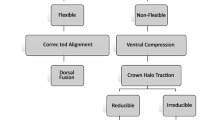Abstract
Purpose
No standard strategy exists for the management of cervical kyphotic deformity in patients with severe osteoporosis. In fact, in such subpopulation, standard algorithms commonly used in patients with normal bone mineral density may not be applicable. In this Grand Rounds, the authors present a challenging case of a patient with Hajdu–Cheney syndrome, a rare disorder of bone metabolism induced by a Notch-2 mutation, who presented with cervical kyphotic deformity and severe osteoporosis.
Methods
A 65-year-old female patient with a previous diagnosis of Hajdu–Cheney syndrome presented with cervical myelopathy and cervical kyphotic deformity. The initial MRi demonstrated multilevel cervical canal stenosis. The CT-scan also revealed marked spondylolisthesis of C6 over C7 as well as numerous laminar and pedicle fractures, resulting in a cervical kyphosis of approximately 50 degrees.
Results
The patient was submitted to 360-degree decompression and fusion of the cervical spine consisting of a staged C6 anterior corpectomy and multilevel microdiscectomies with wide opening of the posterior longitudinal ligament in order to provide a satisfactory release of anterior spinal structures, followed by 24 h of cervical halo-traction, a second anterior approach for bone graft implantation in the site of the corpectomy as well as insertion of allografts and completion of the ACDF C2–T1 and plating, and, finally, a posterior C2–T3 pedicle screw instrumentation using intra-operative CT-scan (O-arm) navigation guidance.
Conclusions
This case illustrates some intra-operative nuances as well as specific surgical recommendations for cervical deformity surgery in patients with severe osteoporosis, such as avoidance of Caspar pins for interbody distraction, use of intra-operative fluoroscopy for achievement of bicortical purchase of anterior cervical screws and placement of pedicle screws during posterior instrumentation. Moreover, such illustrative case demonstrates that, in the subpopulation of patients with severe osteoporosis, it may be possible to successfully apply cervical distraction after an isolated anterior approach with a satisfactory improvement in the cervical alignment, possibly avoiding more laborious 540-degree approaches such as the previously described back–front–back or front–back–front surgical algorithms.





Similar content being viewed by others
References
Hajdu N, Kauntze R (1948) Cranio-skeletal dysplasia. Br J Radiol 21(241):42–48
Cheney WD (1965) Acro-osteolysis. Am J Roentgenol Radium Ther Nucl Med 94:595–607
Brown DM, Bradford DS, Gorlin RJ, Desnick RJ, Langer LO, Jowsey J, Sauk JJ (1976) The acro-osteolysis syndrome: morphologic and biochemical studies. J Pediatr 88(4 Pt 1):573–580
Leidig-Bruckner G, Pfeilschifter J, Penning N (1999) Severe osteoporosis in familial Hajdu–Cheney syndrome; progression of acro-osteolysis and osteoporosis during long-term follow-up. J Bone Miner Res 14(12):2036–2041
Isidor B, Lindenbaum P, Pichon O (2011) Truncating mutations in the last exon of NOTCH2 cause a rare skeletal disorder with osteoporosis. Nat Genet 43(4):306–308
Simpson MA, Irving MD, Asilmaz E, Gray MJ, Dafou D, Elmslie FV, Mansour S, Holder SE, Brain CE, Burton BK, Kim KH, Pauli RM, Aftimos S, Stewart H, Kim CA, Holder-Espinasse M, Robertson SP, Drake WM, Trembath RC (2011) Mutations in NOTCH2 cause Hajdu–Cheney syndrome, a disorder of severe and progressive bone loss. Nat Genet 43(4):303–305
Drake WM, Hiorns MP, Kendler DL (2003) Hajdu–Cheney syndrome: response to therapy with bisphosphonates in two patients. J Bone Miner Res 18(1):131–133
Iwaya T, Taniguchi K, Watanabe J, Iinuma K, Hamazaki Y (1979) Hajdu–Cheney syndrome. Arch Orthop Traumat Surg 95(4):293–302
Udell J, Schumacher HR Jr, Kaplan F, Fallon MD (1986) Idiopathic familial acroosteolysis: histomorphometric study of bone and literature review of Hajdu–Cheney syndrome. Arth Rheum 29(8):1032–1038
Steinmetz MP, Stewart TJ, Kager CD, Benzel EC, Vaccaro AR (2007) Cervical deformity correction. Neurosurgery 60(1 Supp1 1):S90–97
Geisler FH, Caspar W, Pitzen T, Johnson TA (1998) Reoperation in patients after anterior cervical plate stabilization in degenerative disease. Spine 23(8):911–920
Han K, Lu C, Li J, Xiong GZ, Wang B, Lv GH, Deng YW (2011) Surgical treatment of cervical kyphosis. Eur Spine J 20(4):523–536
Mummaneni PV, Mummaneni VP, Haid RW Jr, Rodts GE Jr, Sasso RC (2003) Cervical osteotomy for the correction of chin-on-chest deformity in ankylosing spondylitis. Technical note. Neurosurg Focus 14(1):e9
Hou DJ, Khoueir P, Wang MY (2008) Management of cervical deformity in ankylosing spondylitis. Neurosurg Focus 24(1):E9
Etame AB, Than KD, Wang AC, La Marca F, Park P (2008) Surgical management of symptomatic cervical or cervicothoracic kyphosis due to ankylosing spondylitis. Spine (Phila Pa 1976) 33(16):E559–E564
Shimizu K, Nakamura M, Nishikawa Y, Hijikata S, Chiba K, Toyama Y (2005) Spinal kyphosis causes demyelination and neuronal loss in the spinal cord: a new model of kyphotic deformity using juvenile Japanese small game fowls. Spine 30(21):2388–2392
Simmons EH (1972) The surgical correction of flexion deformity of the cervical spine in ankylosing spondylitis. Clin Orthop 86:132–143
Kim K, Lee S, Son E, Kwack Y, Chun Y, Lee J (2012) Surgical treatment of “chin-on-pubis” deformity in a patient with ankylosing spondylitis: a case report of consecutive cervical, thoracic, and lumbar corrective osteotomies. Spine (Phila Pa 1976) 37(16):E1017–E1021
Sin AH, Acharya R, Smith DR, Nanda A (2004) Adopting 540-degree fusion to correct cervical kyphosis. Surg Neurol 61(6):515–522
Schultz KD Jr, McLaughlin MR, Haid RW Jr, Comey CH, Rodts GE Jr, Alexander J (2000) Single-stage anterior–posterior decompression and stabilization for complex cervical spine disorders. J Neurosurg 93(2 Suppl):214–221
Conflict of interest
The authors declare that there is no conflict of interest and that no funding was received for this work.
Author information
Authors and Affiliations
Corresponding author
Rights and permissions
About this article
Cite this article
Mattei, T.A., Rehman, A.A., Issawi, A. et al. Surgical challenges in the management of cervical kyphotic deformity in patients with severe osteoporosis: an illustrative case of a patient with Hajdu–Cheney syndrome. Eur Spine J 24, 2746–2753 (2015). https://doi.org/10.1007/s00586-015-4092-x
Received:
Revised:
Accepted:
Published:
Issue Date:
DOI: https://doi.org/10.1007/s00586-015-4092-x





